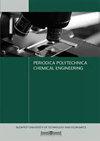利用甜菜浆作为生物吸附剂处理糖化金属离子:间歇生物吸附动力学研究
IF 1.8
4区 工程技术
Q3 ENGINEERING, CHEMICAL
引用次数: 1
摘要
制糖业面临着糖汁提纯后残留大量糖化金属离子的问题。研究了未改性甜菜浆作为弱单功能阳离子交换生物吸附剂对碱化糖汁中发生糖化的金属离子(Na+、K+和Ca2+)的脱除作用。在与工业条件相似的碱化糖汁温度(70℃)和pH(10.5)条件下进行了间歇式生物吸附实验。二价Ca2+的去除率最高(30.2%),而一价Na+和K+的去除率分别为10.9%和9.1%。所有被测金属在90分钟内建立生物吸附平衡。从阳离子交换材料的角度对甜菜果肉进行了表征。利用扫描电子显微镜和傅里叶变换红外光谱对生物吸附剂的结构和官能团进行了表征。采用四种非线性动力学模型(拟一阶、拟二阶和Elovich)和扩散模型(Weber-Morris)对生物吸附数据进行分析。生物吸附过程的时间过程数据符合准一级和准二级动力学模型,表明离子交换和化学吸附是碱化汁中金属离子去除的主要机制。HNO3的解吸效率最高,平均为54.4%。利用甜菜生物量作为阳离子交换材料是一种更成功的糖汁净化的潜在解决方案。本文章由计算机程序翻译,如有差异,请以英文原文为准。
Utilization of Sugar Beet Pulp as Biosorbent for Molassigenic Metal Ions: Kinetic Study of Batch Biosorption
The sugar industry is facing problems with high amount of molassigenic metal ions remained after the purification step in sugar juice. In this investigation the application of unmodified sugar beet pulp as a weak monofunctional cation-exchange biosorbent for molassigenic metal ions (Na+, K+ and Ca2+) removal from the alkalized sugar juice was studied. The batch biosorption experiments were performed at temperature (70 °C) and pH (10.5) of alkalized sugar juice similar to industrial conditions. The highest removal efficiency was noticed for divalent Ca2+ (30.2%), while monovalent Na+ and K+ ions were removed with 10.9 and 9.1% efficiency, respectively. Biosorption equilibrium was established in 90 min for all tested metals. Sugar beet pulp characterization from the perspective of cation-exhange material was conducted. The structure of the biosorbent and an insight of the functional groups were also characterized by scanning electron microscopy and Fourier transform infrared spectroscopy. The biosorption data were analyzed using four non-linear kinetic (pseudo-first order, pseudo-second order and Elovich) and diffusion models (Weber-Morris). The time course data of biosorption processes fitted well to the pseudo-first and the pseudo-second-order kinetic models indicating ion-exchange and chemisorption as dominant mechanisms for metal ions removal from the alkalized juice. HNO3 as a desorption reagent showed the highest average molassigenic metal ions desorption efficiency (54.4%). Utilization of sugar beet biomass as cation-exchange material imposes as a potential solution for more successful sugar juice purification.
求助全文
通过发布文献求助,成功后即可免费获取论文全文。
去求助
来源期刊

Periodica Polytechnica Chemical Engineering
ENGINEERING, CHEMICAL-
CiteScore
3.10
自引率
7.70%
发文量
44
审稿时长
>12 weeks
期刊介绍:
The main scope of the journal is to publish original research articles in the wide field of chemical engineering including environmental and bioengineering.
 求助内容:
求助内容: 应助结果提醒方式:
应助结果提醒方式:


